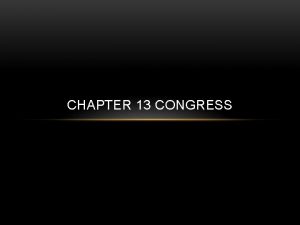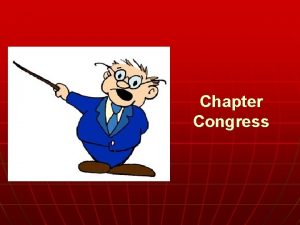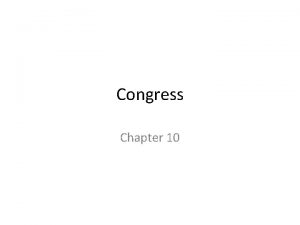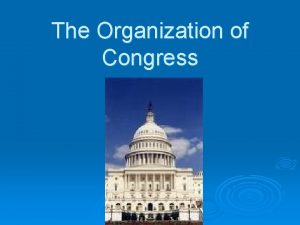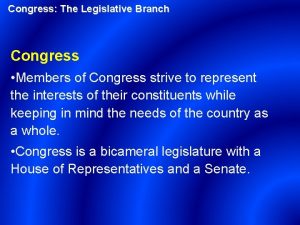Chapter 4 Congress Mark A Peterson 2008 Delmar













- Slides: 13

Chapter 4 Congress Mark A. Peterson © 2008 Delmar Cengage Learning.

U. S. Congress: A Unique Institution • Few other legislatures play such a powerful role when it comes to initiating policy • Accords with the “consensus” model of policy making – Interests must bargain with numerous institutional actors in order to achieve positive outcome on any given issue 2 © 2008 Delmar Cengage Learning.

U. S. Congress: A Unique Institution • Lack of competing national (unifying) institutions – Tradition of bureaucratic government ensures Congress retains powerful role in policymaking 3 © 2008 Delmar Cengage Learning.

The Changing Face of Congress • Party unity/discipline has changed over time – Generally lower than in majoritarian systems • House started 20 th century as a highly centralized institution – Power gradually decentralizing over time – Up to the 1990 s 4 © 2008 Delmar Cengage Learning.

The Fate of Health Care Reform in Congress-1 • National health care reform legislation first introduced (gingerly) by Robert Wagner in 1939 • President Truman made health care reform a priority – Further reform attempts were made in the 1970 s – Most recently, in 1993 -’ 94 5 © 2008 Delmar Cengage Learning.

The Fate of Health Care Reform in Congress-1 • Not a single piece of health care reform legislation ever made it to the stage of debate on the floor of the House or Senate 6 © 2008 Delmar Cengage Learning.

The Fate of Health Care Reform in Congress-2 • Despite Democratic majorities in mid-20 th century and party leadership commitment to health care reform – Party cohesion in Congress was low throughout the period 7 © 2008 Delmar Cengage Learning.

The Fate of Health Care Reform in Congress-2 • Conservative southern Democrats managed to scuttle reform efforts through the mid-1960 s • Next, the American Medical Association (AMA) became an obstacle to reform 8 © 2008 Delmar Cengage Learning.

The Fate of Health Care Reform in Congress-2 • Newer groups such as the National Federation of Independent Business (NFIB) led interest group opposition to health care reform legislation over time 9 © 2008 Delmar Cengage Learning.

Presidential Strategy and Health Care Reform • President Clinton waited too long to unveil reform plan – Too close to the midterm elections • Ordering of process also proved faulty – Administration hoped to prevail in the House before moving on to the Senate but this did not work 10 © 2008 Delmar Cengage Learning.

Presidential Strategy and Health Care Reform • Lengthy (secretive) process of formulating reform plan gave interest groups time to galvanize members against it • Intensity of opposition generated greater than expected enthusiasm among natural allies 11 © 2008 Delmar Cengage Learning.

Chapter 4 Summary • Congress is unique among the legislatures of the world • Structural profile of Congress has changed significantly over time 12 © 2008 Delmar Cengage Learning.

Chapter 4 Summary • Congress has often served as the graveyard of health care reform legislation • Clinton health care reform package died largely as a result of poor legislative strategy 13 © 2008 Delmar Cengage Learning.
 Trigrams for replican of peterson and peterson
Trigrams for replican of peterson and peterson 2008 2008
2008 2008 2009 delmar cengage learning
2009 delmar cengage learning 2009 delmar cengage learning
2009 delmar cengage learning Clinical conditions chapter 1 medical terminology
Clinical conditions chapter 1 medical terminology Measuring and recording apical pulse
Measuring and recording apical pulse Delmar isotonic
Delmar isotonic Delmar tsi
Delmar tsi Delmar customs broker windsor
Delmar customs broker windsor Delmar thomson learning
Delmar thomson learning Chapter 6 the skeletal system answer key
Chapter 6 the skeletal system answer key 2009 delmar cengage learning
2009 delmar cengage learning Chapter 10 cultural diversity
Chapter 10 cultural diversity Borgify
Borgify














